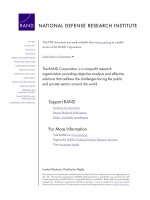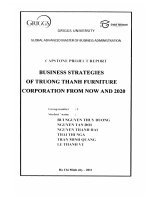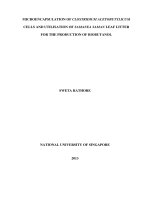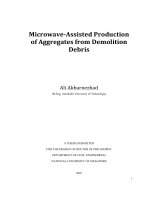Fermentative production of vinegar from grapes and guava using adsorbed cells of Acetobacter aceti
Bạn đang xem bản rút gọn của tài liệu. Xem và tải ngay bản đầy đủ của tài liệu tại đây (219.95 KB, 8 trang )
Int.J.Curr.Microbiol.App.Sci (2017) 6(5): 2005-2012
International Journal of Current Microbiology and Applied Sciences
ISSN: 2319-7706 Volume 6 Number 5 (2017) pp. 2005-2012
Journal homepage:
Original Research Article
/>
Fermentative Production of Vinegar from Grapes and
Guava Using Adsorbed Cells of Acetobacter aceti
Sourav Kumar1, Gurvinder Singh Kocher1* and Dapinder Kaur Bakhsi2
1
Department of Microbiology, Punjab Agricultural University, Ludhiana, India
2
Punjab State Council for Sciences and Technology, Chandigarh, India
*Corresponding author
ABSTRACT
Keywords
Adsorption,
Grape vinegar,
Guava vinegar,
Saccharomyces
cerevisiae,
Semi-continuous
fermentation,
Wood shavings
Article Info
Accepted:
18 April 2017
Available Online:
10 May 2017
Natural vinegar is a food supplement, tonic and nutraceutical produced by twin
fermentation of sugar to acetic acid via ethanol. The fermentation of grape and
guava juice carried out by Saccharomyces cerevisiae MTCC 11815 produced
9.25% (v/v), 9.32% (v/v) of ethanol with a fermentation efficiency of 92.6%,
93.9% in 72 h and 96 h, respectively. The optimized conditions for sugarcane
vinegar production were also validated for grape and guava vinegar production up
to 5L in PVC column reactors that yield 6.2% (w/v) and 6.1% (w/v) volatile
acidity in 8-10 days, respectively. The grape and guava vinegars possessed in vitro
antioxidant potential with total free radical scavenging activities with EC50 and
AEAC values of 83.4% and 88.9%, 63.6 and 57.0; 0.27 µM and 0.30 µM,
respectively. Both the vinegars had a mean sensory score of 7.52±0.75 Grape and
7.60±0.83 Guava in comparison to a commercial brand having 8.48±0.59 score.
Introduction
India ranks second in fruits and vegetables
production in the world, after China with an
annual production of 86.602 million metric
tonnes of fruits and 169.478 million metric
tonnes of vegetables (NHB 2015-16). Among
different fruits, grapes and guava have
fascinated the local consumers due to their
pleasant, sub-acid and aromatic nature.
Biochemically, guava is rich in vitamin A
(200-400 IU), ascorbic acid (88.2-250.8
mg/100 g), lycopene (45.3 μg/ g FW), total
sugars (10-15.3%), reducing sugars (2.056.08%), acids (10-15.3%), pectins (0.62%)
and phenols (170- 345 GAE/ g FW). At
maturity, grape berries possesses water
(74%), sugars (25%, primarily fructose and
glucose), organic acids (0.8%, primarily
tartaric and malic acids), minerals (0.5%,
mainly potassium), phenolics, flavonoids,
aromatics and nitrogenous compounds (0.2%)
which make them nutritious substrates (Pooja
et al., 2016). However, these fruits are
marked with a very low shelf-life of about 2-3
days for grapes and 5-7 days for guava at
room temperature and thus reflect 10-15%
post-harvest losses, which make them ideal
candidates for value-addition. Though guava
nectars/ juices are available in market, very
little work has been carried out towards
guava-wine and vinegar production (Kocher
2005
Int.J.Curr.Microbiol.App.Sci (2017) 6(5): 2005-2012
and Pooja, 2011). Natural vinegar is a
fermented product of increasing significance
by virtue of its widely variable origin and use
particularly as a condiment and food
preservative. The present industry dealing
with the production of natural vinegar still
uses the traditional batch fermentation which
generally spans 4-5 weeks (Lea 1989;
Fregapane et al., 2003; Sossou et al., 2009).
Batch scale technologies for sugarcane and
grape vinegar fermentation at 50L scale were
earlier developed in our laboratory that took
25-28 days for producing vinegar (Kocher et
al., 2014). Since immobilized cells technique
is known to enhance fermentation (Kocher et
al., 2006), a semi-continuous sugarcane
vinegar production technology using wood
shaving adsorbed cells has also been
developed with a reduced fermentation time
without compromising vinegar quality
(Kumar and Kocher, 2016). In the present
study, the latter has been standardized and
validated for two types of vinegar production
viz. grapes and guava.
Materials and Methods
Grape juice and guava juice had a brix of
17.0±2 and 5.0±1.5 ˚B, respectively and a pH
of 4.5±0.2 were observed for both fruits.
Brix–acid ratio of guava juice was adjusted in
the desirable range by using sugar (raising
Brix to 17.0°B) and citric acid, while the
same was already found in the desirable range
in case of grapes. The cultures used in the
study viz; Saccharomyces cerevisiae MTCC
11815 and Acetobacter aceti AC1 were local
isolates of our laboratory.
Ethanolic fermentation
Ethanolic fermentation of grape and guava
juice (50L) were performed by inoculating
freshly prepared 24 h old inoculum of S.
cerevisiae MTCC 11815 (in jaggary solution
@ 150 g/l) @ 6% (v/v) and 9% (v/v),
respectively followed by incubation at
28±2°C (Pooja et al., 2014; Joshi, 2010) till
the bubbling ceased and 'lees' settled at
bottom of the container. The final ethanol
concentration was analysed by the dichromate
oxidation method (Caputi and Wright, 1969).
Acetic acid fermentation
The acetic acid fermentation of grape and
guava ethanol was carried out in 7L plastic
column fermenters. The conditions for
adsorption of A. aceti cells and packing length
were earlier optimized for sugarcane vinegar
production in indigenously prepared plastic
columns having capacity of 1L and 7L with
working volumes of 800ml and 5L,
respectively (Kumar and Kocher, 2016).
These standardized conditions were validated
for grape and guava vinegar production in 5L
scale. Each column was packed with A. aceti
cells adsorbed wood shavings and charged
with grape and guava alcohol mixed with
mother vinegar in a ratio of 3:2, so as to have
an initial acidity of 2% (w/v). The fermenters
were incubated at 28±2°C and used to
measure volatile acidity (AOAC 1980) and
residual alcohol as discussed earlier, The
results of fermentation were analysed
statistically using CPCS1.
In vitro antioxidant potential
The in vitro antioxidant potential of
fermented vinegar was estimated as total free
radical scavenging activity by DPPH method
(Sanchez-Moreno et al., 1999). The EC50 and
AEAC values of fermented vinegar were also
calculated by the method of Shimamura et al.,
(2014).
Storage and sensory analysis
The grape and guava vinegars produced were
stored at 4ºC, for 3-4 days, and the settled
bacterial cells and sediment were separated.
2006
Int.J.Curr.Microbiol.App.Sci (2017) 6(5): 2005-2012
The partially clarified vinegars were bottled,
pasteurized (using a water bath at 65ºC for 30
min) and stored at room temperature. The
sensory analysis of at least 3-months-old
vinegars was performed by 10 judges at a
modified 10 point Hedonic scale (Amerine
and Roessler, 1976), which included five
parameters
viz;
appearance,
colour,
astringency, sourness, bouquet and compared
with a commercial brand.
Results and Discussion
Ethanolic fermentation
The physicochemical analysis of grape juice
revealed a TSS content of 17.0°B with total
and reducing sugars of 16.2 and 15.52%
(w/v),
respectively.
The
ethanolic
fermentation of grape juice using S. cerevisiae
MTCC 11815 (6% w/v) was ceased in 72 h
producing an ethanol of 9.25% (v/v) with a
fermentation efficiency of 85.0% (Table 1)
under conditions optimized earlier (Pooja,
2016). In literature, Kocher et al., (2009)
recorded 11.04% (v/v) grape ethanol
production from 20°B with fermentation
efficiency of 90%. Yan et al., (2009) reported
ethanol production of 143.8 g/l from grapes.
The fermentation of guava juice (adjusted to
17.0°B) also carried out using S. cerevisiae
MTCC 11815 (9% w/v) was ceased in 96 h
producing an ethanol of 9.32% (v/v) from
reducing sugars (15.85% w/v) with a
fermentation efficiency of 85.6% (Table 1).
Pooja and Kocher (2014) optimized the guava
ethanol production conditions leading to
production of guava ethanol in the range of
12.0-13.0% (v/v) in 6 days with fermentation
efficiency of 81%. Srivastava et al., (1997)
reported that 10% inoculum size added in
Guava pulp led to the production of 5.8%
ethanol (w/v) by S. cerevisiae. Sveda and
Rodrigues (2011) optimized 22ºB and 25ºC
and 0.06% Diammonium phosphate (DAP)
concentration for guava must fermentation.
Acetic acid fermentation by adsorbed cells
In our earlier study, a half length packed PVC
column with the Melona grandis (15mm)
wood shavings adsorbed cells (in the ratio of
2:1 with A. aceti for 15h with 0.2% DAHP
supplementation at 28ºC) produced sugarcane
vinegar in 6 days from a initial acidity of 2%
(w/v) (Kumar and Kocher, 2016). These
optimized conditions on sugarcane vinegar
production were validated for grape and
guava vinegar production at 7L scale. The
results presented in Table 2 revealed
production of grape and guava vinegar with
high acidity of 6.2% (w/v) and 6.1% (w/v),
respectively in 8-10 days which is more than
that of sugarcane vinegar as well as the limits
prescribed by FSSAI (Gaur, 2011).
Earlier, De Ory et al., (2004) reported vinegar
production in 225L pilot plant producing high
quality vinegar with 100% yield. Similarly,
Krusong and Vichitroka (2011) reported corn
vinegar production in a recycling 10L semicontinuous fermentation system producing
high acidity (6.8-7.2 % w/v) vinegar in 4-5
days.
In vitro antioxidant potential
Estimation of free radical scavenging
activity for DPPH
The DPPH scavenging activity (Fig. 1) of
grape and guava vinegar was tested that
revealed EC50 values of 63.6 and 57.0 µM
with AEAC values of 0.27 and 0.30 µM,
respectively (Table 3). Further, EC50 of
ascorbic acid taken as positive control was
17.2 µM.
Earlier, grape juice has been shown to possess
DPPH activity in the range of 8.23 ± 0.17,
2007
Int.J.Curr.Microbiol.App.Sci (2017) 6(5): 2005-2012
2.51 ± 0.03 and 8.24 ± 0.19 mM in
homemade, commercial and organic juice,
respectively (Burin et al., 2010). Wine
vinegar is also reported to contain
significantly higher total polyphenol content
and hence possess greater antioxidant
capacity compared to distilled vinegar
(Pinisodom et al., 2010). The ORAC-FL
values varied from 14.6 to 25.0 μmol of trolox
equivalents/ml for red grape juices, from 3.5
to 11.1 μmol of trolox equivalents/ml for
white grape juices, and from 4.5 to 11.5 μmol
of trolox equivalents/ml for wine vinegars
(Alberto et al., 2005). Guava wines from
Hisar Safeda and Hisar surkha were found to
have antioxidant activity of 26.2 and 26.4%,
respectively (Sharma, 2015).
Table.1 Ethanolic fermentation of Grape and Guava juice by S. cerevisiae MTCC 11815
Fermentation
Period (h)
0
24
48
72
FE (%)
0
24
48
72
96
FE (%)
TSS (Brix)
17±0.20
11±0.15
2.5±0.10
0.0
17±0.15
13±0.15
7.5±0.20
2.5±0.10
0.0
Grapea
Reducing
Total Sugars
Sugars
16.1±0.13
15.6±0.12
9.9±0.14
9.3±0.07
1.3±0.08
0.7±0.05
0.4±0.07
0.0±0.06
92.6
b
Guava
16.4±0.11
15.5±0.7
12.2±0.08
11.6±0.10
6.4±0.05
5.3±0.08
1.4±0.04
0.7±0.04
0.7±0.03
0.0±0.03
93.9
Cultural conditions:
Scale of fermentation : 50 L
Temperaturea: 28±2ºC
a
Inoculum
: 6% (v/v) Inoculumb : 9% (v/v)
4.8±0.05
4.6±0.1
4.4±0.05
4.1±0.05
Ethanol (%
v/v)
0.0
3.5±0.05
8.5±0.07
9.25±0.05
5.5±0.05
5.2±0.04
4.8±0.05
4.6±0.1
4.4±0.05
0.0
1.9±0.1
5.4±0.07
8.3±0.05
9.32±0.05
pH
Temperatureb: 25±2ºC
Calculations:
Actual ethanol produced
Fermentation Efficiency (FE) =
× 100
Theoretical ethanol produced
Theoretical Ethanol% (v/v) = Sugar utilized × 0.64
Sugar Utilized (on brix basis) = Available sugar - Sugar present after fermentation
2008
Int.J.Curr.Microbiol.App.Sci (2017) 6(5): 2005-2012
Table.2 Semi-continuous fermentation of grape and guava ethanol in packed
bed fermenters at 5L scale
Fermentation
cycles
Initial
2.0
1
2.3
2
2.1
3
2.3
4
2.1
5
2.6
6
2.6
7
2.2
8
2.1
9
2.4
10
2.3±0.21
Mean±S.D.
Fermentation
efficiency
(%)
Yield (g/g)
CD5%
Fermentation conditions:
Temperaturea
Initial alcohola
Residual alcohola
Grapea
Final
6.2
6.1
6.6
7.0
5.9
5.5
5.8
6.3
6.1
6.2
6.2±0.41
Days
11
8
7
7
9
8
9
8
7
7
8.1±1.3
Initial
2.0
2.8
2.1
2.2
2.1
2.2
2.0
2.0
2.5
2.4
2.2±0.26
Guavab
Final
6.0
5.9
6.0
6.5
5.2
5.6
6.7
7.1
5.8
6.5
6.1±0.56
79.6
78.3
0.78
0.76
Days
13
9
9
10
7
8
9
8
9
8
9.0±1.63
0.083
Temperatureb
: 28±2ºC
b
Initial alcohol
: 7.5% (v/v)
Residual alcoholb : 0.7±0.2% (v/v)
: 28±2ºC
: 7.0% (v/v)
: 0.5±0.2% (v/v)
Table.3 DPPH scavenging activity in respect of different concentrations of
Grape and Guava vinegar
Concentration
(µM)
20
40
Ascorbic acid
60
(1mM)
80
100
10
50
Grape vinegar
100
10
50
Guava vinegar
100
EC50 of ascorbic acid (µM)
AEAC =
EC50 of samples (µM)
% DPPH
scavenging
activity
55.1
94.7
95.6
96.3
96.9
5.78
39.4
83.4
7.27
41.5
88.9
2009
EC50 Value
(µM)
AEAC (µM)
17.2
1.0
63.6
0.27
57.0
0.30
Int.J.Curr.Microbiol.App.Sci (2017) 6(5): 2005-2012
Table.4 Sensory evaluation of vinegar produced by semi-continuous fermentation and
commercial vinegar
Sensory
analysis
Maximum
Points
Vinegar sensory score*
Commercial
Grape
Guava
2
1.74±0.06
1.81±0.02
1.73±0.08
Appearance
2
1.58±0.14
1.78±0.07
1.74±0.07
Colour
2
1.79±0.15
1.25±0.22
1.21±0.26
Astringency
2
1.68±0.06
1.48±0.27
1.55±0.19
Sourness
2
1.69±0.18
1.20±0.17
1.37±0.23
Bouquet
10
8.48±0.59
7.52±0.75
7.60±0.83
Total
* The above scoring is mean (±) standard deviation of evaluation by 10 penalists
* Sensory quality:
9-10: Outstanding vinegar, 7-8.99: Standard vinegar, 5-6.99: Commercial vinegar,
3-4.99: Below commercial vinegar acceptability, 1-2.99: Spoiled vinegar
Fig.1 Percent DPPH scavenging activity of grape and guava vinegar with ascorbic acid as
positive control for calculating EC50 values (y=Ax+B)
Storage and sensory analysis
The sensory analysis of aged vinegars (at least
3 months old) was carried out at 10 point
hedonic scale to find out its acceptability
among the tasters. The vinegar produced by
semi-continuous method over the 10 cycles
was found to be consistent in terms of sensory
attributes. It was found that grape and guava
vinegars were acceptable with a mean score
of 7.52±0.75 and 7.60±0.83, whereas mean
score of vinegar produced commercially was
8.48±0.59, respectively (Table 4). The results
showed that both the vinegars produced by
semi-continuous method as of standard
quality and there is not much difference in the
2010
Int.J.Curr.Microbiol.App.Sci (2017) 6(5): 2005-2012
sensory qualities of vinegar produced
commercially. In literature, Kumar and
Kocher (2016) analysed the characteristics of
sugarcane vinegar produced by semicontinuous fermentation on hedonic scale and
categorised it of standard quality. Sharma
(2015) studied the sensory characteristics of
guava vinegar in terms of color, aroma, taste
and overall acceptability and rated the guava
vinegar in superior quality range with a score
of 8.0 out of 10.0.
In conclusion, in the present study, semicontinuous fermentation vinegar production
in respect of guava and grapes was successful
accomplished at 5L scale in indigenous PVC
column reactors produces 6.2% (w/v) and
6.1% (w/v) volatile acidity in 8-10 days,
respectively. The grape and guava vinegar
possessed in vitro antioxidant potential with
total free radical scavenging activity of 83.4%
and 88.9%, respectively, thus revealing
potential commercial applications of the
developed economical technology.
Acknowledgement
The authors thank Dr M.I.S. Gill (Head,
Department of Fruit Science, PAU) for
providing raw material for the study.
References
Amerine, M.A., and Roessler, E.B. 1976.
Wines: Their Sensory Evaluation (2nd ed.)
W.H. Freeman & Co., New York. Pp 3637.
AOAC. 1980. Official methods of analysis. 13th
ed. Assoc. and Chem. Washington DC:
504.
Burin, V.M., Falcao, L.D., Gonzaga, L.V., Fett,
R., Rosier, J.P., Bordignon-Luiz1, M.T.
2010. Colour, phenolic content and
antioxidant activity of grape juice. Cienc.
Tecnol. Aliment. Campinas, 30(4): 10271032.
Caputi, A., Wright, D. 1969. Collaborative
study of determination of ethanol in wine
by chemical oxidation. J. Assoc. Anal.
Chem, 52: 85.
Davalos, A., Bartolome, B., and GomezCordoves, C. 2005. Antioxidant
properties of commercial grape juice
and vinegar. Fd. Chem., 93(2): 325-330.
De Ory, I., Romero, L.E., and Cantero, D. 2004.
Optimization
of
immobilization
conditions for vinegar production. Siran,
wood chips and polyurethane foam as
carriers for Acetobacter aceti. Process
Biochem. 39(5): 547–555.
Fregapane, G., Fernández, H. R., and Salvador,
M. D. 2003. Continuous production of
wine vinegar in bubble column reactors of
up to 60-litre capacity. European Fd. Res.
Technol., 216: 63–67.
Gaur, V.N., CEO, Food Safety and Standards
Authority of India. 2011. Chapter 2.3.46
Vinegar. In. The Gazette of India:
Extraordinary [Part III—Sec. 4], Ministry
of Health and Human Welfare, 354. New
Delhi: www.fssai.gov.in.
Joshi, N. 2010. Standardisation of fermentation
conditions for production of concentrated
sugarcane vinegar. MSc Thesis, PAU,
Ludhiana.
Kocher, G.S., and Pooja. 2011. Status of wine
production from guava (Psidium guajava
L): A traditional fruit of India. African J
Food Sci., 5: 851-860.
Kocher, G.S., Kalra, K.L., and Phutela, R.P.
2006. Comparative production of
sugarcane
vinegar
by
different
immobilization techniques. J. Institute of
Brewing, 112(3): 264-266.
Kocher, G.S., Phutela, R.P., and Gill, M.I.S.
2009. Evaluation of grape varieties for
wine production. Ind. J. Hort., 66(3):
410-412.
Kocher, G.S., Phutela, R.P., Dhillon, H.K.,
Uppal, S.K., Arora, J.K., and Bakshi, D.
2014. Standardization of an economical
bioprocess for production of natural
vinegar from sugarcane. Sugar Tech.,
16(1): 15–21.
Krusong, W., Vichitraka, A. 2011. An air-lift
acetifier with mash recycling system for
2011
Int.J.Curr.Microbiol.App.Sci (2017) 6(5): 2005-2012
corn vinegar production by Adsorbed
cells of Acetobacter aceti WK on surface
of loofa sponge. In 2nd International
conference on biotechnology and food
science IPCBEE, vol.7, 86–90.
Kumar, S., and Kocher, G.S. 2016. Upscaled
production of sugarcane vinegar by
adsorbed cells of Acetobacter aceti under
semi-continuous fermentation conditions.
Sugar Tech., DOI 10.1007/s12355-0160487-1.
Lea, A.G.H. 1989. Cider vinegar. In Processed
Apple Products, ed. D.L. Downing, 279301. New York: Van Nostrand Reinhold.
Pinsirodom, P., Rungcharoen, J., and
Liumminful, A. 2010. Quality of
commercial wine vinegars evaluated on
the basis of total polyphenol content and
antioxidant properties. As. J. Food AgInd., 3(4): 389-397.
Pooja. 2016. Optimization of enological
practices for production of quality wines
from grapes. PHD Thesis, PAU,
Ludhiana.
Pooja and Kocher, G.S. 2014. Fermentative
production of guava-wine (Psidium
guajava L) using S. cerevisiae MTCC
11815. Curr. Nutri. Food Sci., 10: 1.
Pooja, Kocher, G.S., and Gill, M.I.S. 2016.
Dynamics of biochemicals of Punjab
MACS Purple and H-144 from veraison
to maturity under Punjab conditions.
Indian J. Hort., 73(3): 400-404.
Sanchez-Moreno, C., Larrauri, J. A., and SauraCalixto, F. 1999. Free radicals scavenging
capacity and inhibition of lipid oxidation
of wines, grape juices and related
polyphenolic constitutes. Fd. Res. Int., 32:
407-412.
Sevda, S.B., and Rodrigues, L. 2011.
Fermentative
behaviour
of
Saccharomyces strains during Guava
(Psidium Guajava L) must fermentation
and
optimization
of
Guava-wine
production. J. Food Process Technol.
Sharma, P. 2015. Preparation of value added
vinegar from guava (Psidium guajava L.)
M.Sc thesis, CCSHAU, Hisar.
Shimamura, T., Sumikura, Y., Yamazaki, T.,
Tada, A., Kashiwagi, T., Ishikawa, H.,
Matsui, T., Sugimoto, N., Akiyama, H.,
and Ukeda, H. 2014. Applicability of the
DPPH assay for evaluating the
antioxidant capacity of food additives inter - laboratory evaluation study. Anal.
Sci., 30: 717-21.
Sossou, S.K., Ameyapoh, Y., Karou, S.D., and
Souza, C.D. 2009. Study of pineapple
peelings processing into vinegar by
biotechnology. Pak. J. Biol. Sci., 11: 859–
865.
Srivastava, S., Modi, D.R., and Garg, S.K.
1997. Production of ethanol from Guava
pulp by yeast strains. Biores. Technol.,
60: 263-265.
Yan, L., Tiansheng, Q., Naikun, S., Mingzhe,
G., Yanling, J., and Hai, Z. 2009.
Improvement of ethanol concentration
and yield by initial aeration culture in
very high gravity fermentation. Chin. J.
Appl. Environ. Biol., 15(4): 563-67.
How to cite this article:
Sourav Kumar, Gurvinder Singh Kocher and Dapinder Kaur Bakhsi. 2017. Fermentative
Production of Vinegar from Grapes and Guava Using Adsorbed Cells of Acetobacter aceti.
Int.J.Curr.Microbiol.App.Sci. 6(5): 2005-2012. doi: />
2012









